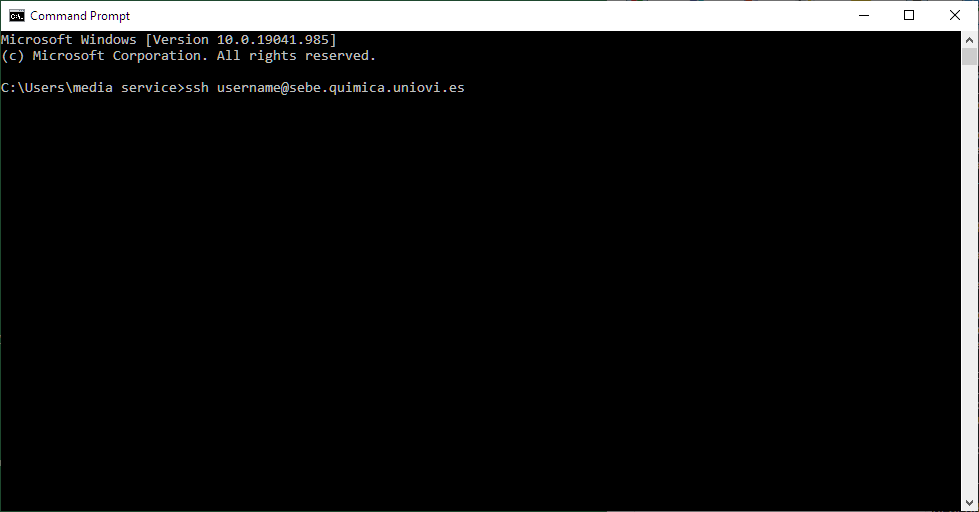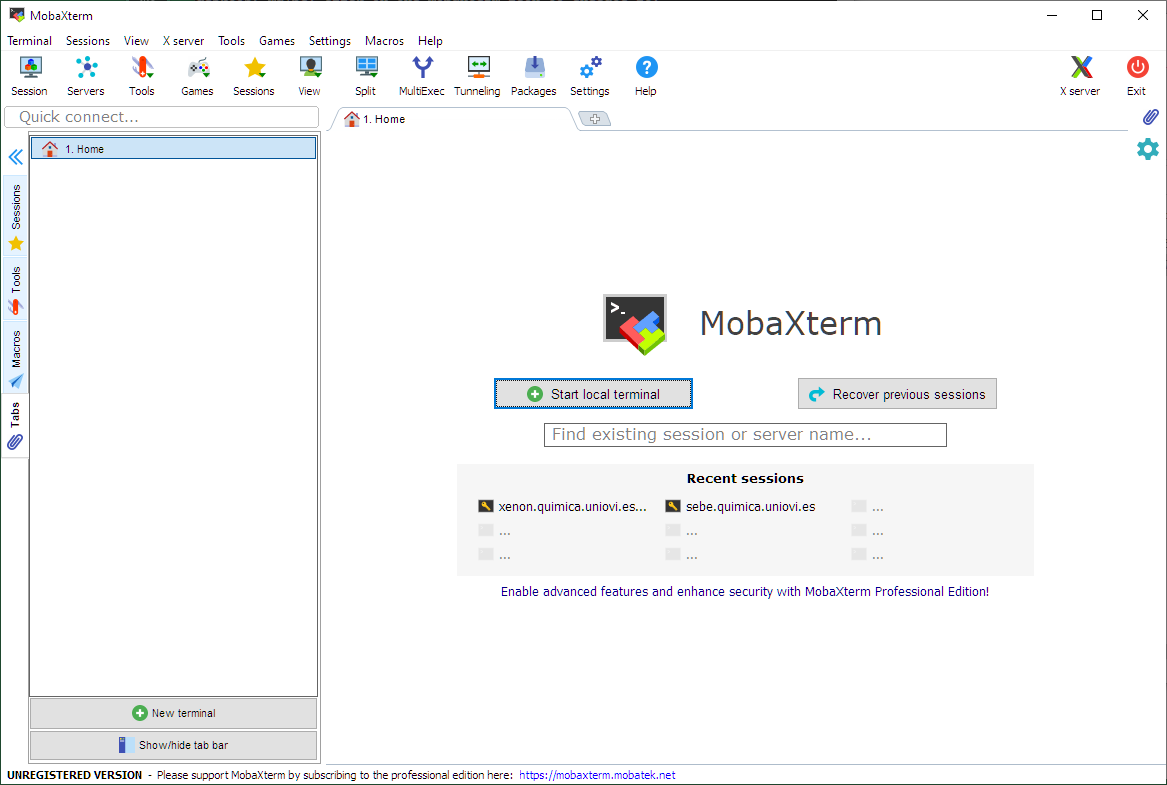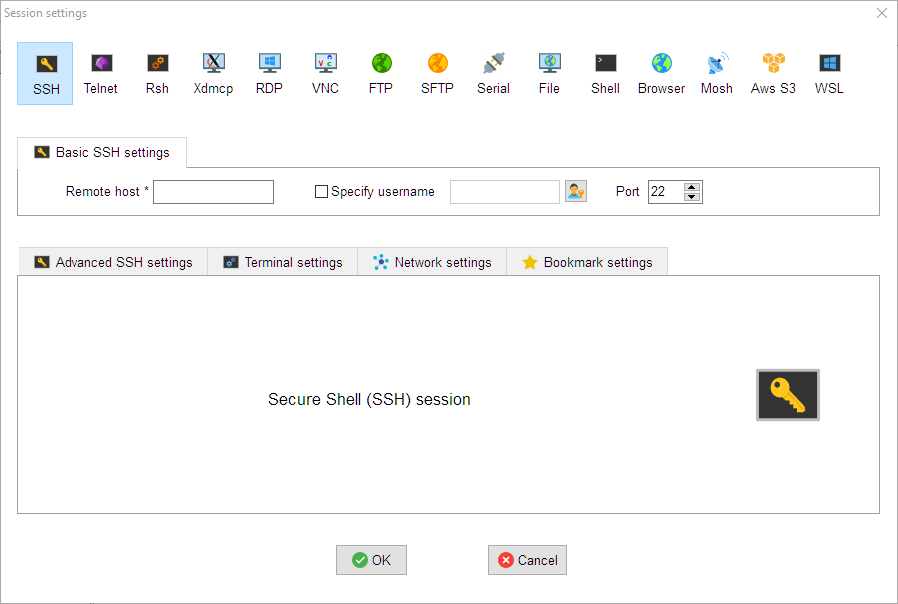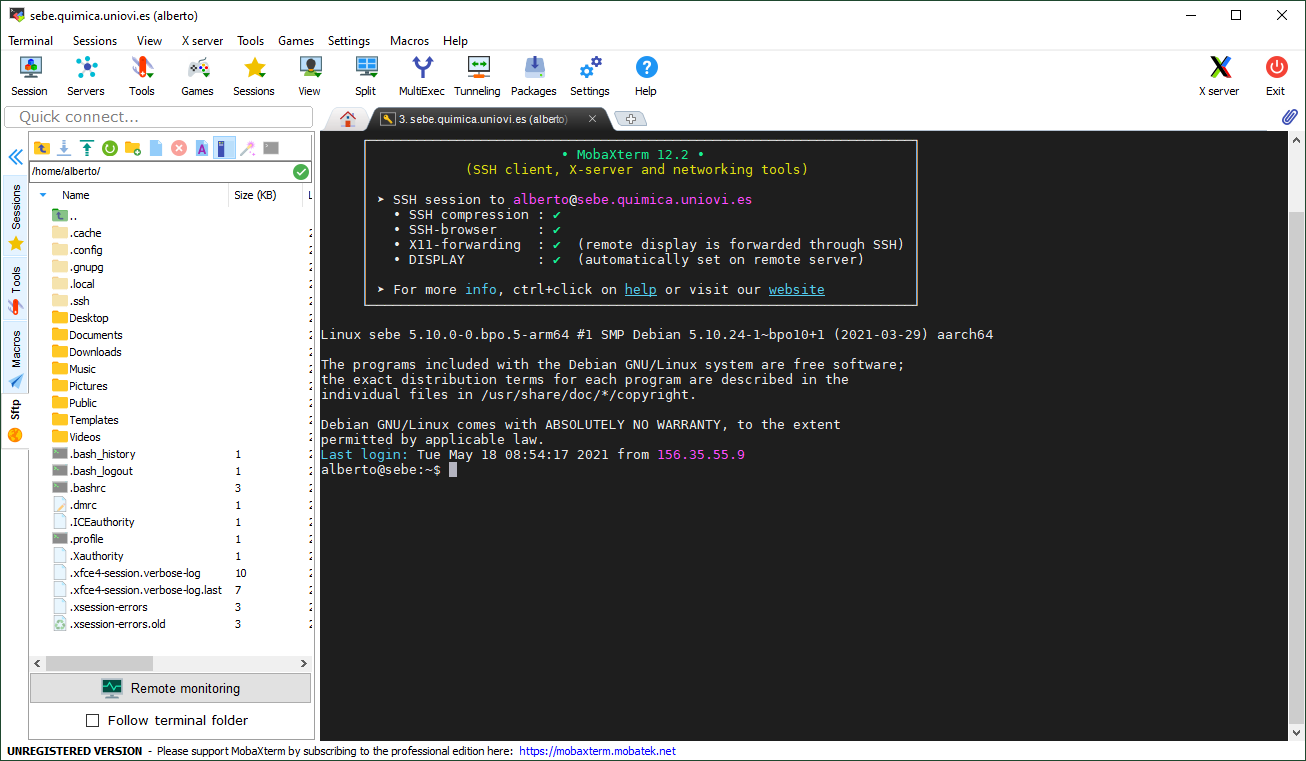(1) Connecting to a Remote Computer Using SSH
Introduction
Most of the work in computational chemistry, and other computational fields of science, is done with the Linux terminal. This is because the software we use does not normally come with a graphical interface and also because, once you know how to use it, the terminal allows working very efficiently with large amounts of data.
To work with the terminal, the user enters commands that perform specific tasks. These include reading, creating, and deleting files, filtering lines out of a text file, mass renaming, running calculations, and many more. For instance:
sebe:~$ ls
Desktop Documents Downloads Music Pictures Public Templates Videos
Here, sebe:~$ is the command prompt (the place you type at), ls is
the command we entered (followed by ENTER) and Desktop ... is the
effect of the ls command, in this case, displaying the contents of
the working directory. Working with the terminal is awkward at first
because you need to remember the names, syntax, and purpose of the
commands but, as you get familiar with it, you will see that it is
much more powerful for most tasks than the graphical interfaces you
are probably used to.
To run chemical calculations, we typically connect remotely to computers other than the one we are using. There are several reasons for this. First, the calculations may be too complex or too numerous and therefore we need specialized high-performance computers to handle the workload. Second, the remote computer may have software installed that is not available in our desktop; computational chemistry software often have licenses that limit their installation to certain computers. Lastly, information and data can be shared between users of the same remote computer, for instance, if you are working in a research team. This tutorial briefly explains how to connect to another computer remotely using ssh.
The Secure Shell Protocol (ssh)
Our main way of connecting to a remote computer is the ssh (secure shell) protocol. The ssh protocol allows encrypted communication between two machines. Ssh is implemented in a client-server model. The remote computer (the server) you want to connect to runs the ssh server and you use an ssh client installed on your computer to connect to this server. Once the connection is established, the server issues a challenge, typically a request for a password. If you enter the (correct) password, you log into the server. At that point, all the commands you enter will run on the remote machine.
For logging into a computer via ssh you need:
1) The name or IP of the remote machine.
2) The user name of your account in the remote machine.
3) The password.
For the remainder of these tutorials, we will use the following remote computer:
sebe.quimica.uniovi.es
and the username and password that were given to you. As soon as you connect to this machine, you should first change your password by using the passwd command.
To connecting to the server, you first need to install an ssh client on your computer. You have multiple options depending on your operating system. How to do this with a few ssh clients is explained below.
Note: unless you copy large files back and forth, an ssh connection is very lightweight. You can follow these tutorials using a metered connection (e.g. mobile phone data); it won’t impact your data usage significantly.
Microsoft Windows
The Windows Command Line (cmd)
If you are running Windows 10 or a later version, an ssh client may
already be available in your system, although you probably want to
download and use MobaXterm anyway. To see if this is the
case, go to the search bar and write and execute cmd. This will open
the system command prompt:

Note: the commands described in these tutorials won’t work in the windows command line because it is using a different shell program (a different interpreter for the user commands).
To connect to the server, type:
ssh <username>@sebe.quimica.uniovi.es
where <username> is your user name. The server will ask for your
password. If you enter it successfully, you will be greeted with the
message of the day and the prompt. You are now connected to the remote
computer via ssh.
Note: the password doesn’t show as you type it. If you mess up entering your password, you can clear what you typed by pressing Control-u.
Important: change your password the first time you log in using the passwd command.
To close the remote connection, write exit in the command line or
type Control-d. This will terminate the ssh connection and get you
back to the local terminal on your computer.
MobaXterm
MobaXterm is a graphical ssh client for Windows. It is not open source but the “home version” is free to use. MobaXterm has some convenient features. It can open multiple ssh sessions and store the connection information, and it also provides an easy way to copy files between both computers.
To install MobaXterm, go to the download page and click on the “download now” button. You can choose whether to install the portable edition (no installation required, recommended) or the installer edition. If you selected the portable edition, unpack the zip file in your desktop and click on the MobaXterm icon to execute it.
The first time you run MobaXterm it will ask for a master password. This master password is used to unlock your saved ssh connection information such that you won’t have to enter your password every time you connect to a remote server (only the first time). Type a secure master password that you will remember. Once you are done, the mobaxterm window will open:

To connect to a remote computer, click on the Session button (top left) and select the ssh tab.

Enter the name or IP of the remote computer in “Remote host”. Check the “Specify username” box and write your user name in the text field. Then, click OK.
Note: it is recommended that you click on the “advanced SSH settings” and deselect “X11-forwarding”. This will prevent the server from trying to open windows on your computer. Unless you have a very fast internet connection, this is painfully slow.
Note: if a Windows Firewall window pops up, click “allow access” to allow MobaXterm to establish the ssh connection.
A terminal will now open and ask for your password. Enter your password (the letters won’t show; you can clear what you typed with Control-u). If you do this correctly, you will be logged into the remote server. Before that, MobaXterm will likely ask whether you want to store the connection information. If you say “yes”, you won’t have to enter the password again (only the master password when you open MobaXterm).
To close the ssh connection, type exit or press Control-d.
Note: your session details are saved. You can reconnect to the same server by double clicking on the server name in the left tab.
Note: MobaXterm also provides a terminal that runs on your own computer. You can open this by clicking on “start local terminal”, in the large area on the right. Most of the commands we will see work in this terminal. However, some you will have to install:
apt-cyg install octave avogadro gnuplot emacs
and some won’t be installable at all (e.g. Gaussian). You can use the
ssh command in the local terminal to connect to a remote server, as
in Linux.
Linux and OSX
To use the ssh client on Linux and OSX, you need to open a
terminal. On OSX, you can do this by using the spotlight search (with
Command-Space) and then typing terminal. On Linux, how to open a
terminal depends on the distribution you use, but typically can be
done via the menus of your window manager or by typing “terminal” in
the application search bar.
The terminal you opened is running on your local computer. To connect to the remote server, do:
ssh <username>@sebe.quimica.uniovi.es
where <username> is your user name on the remote machine.
Note: Depending on the Linux distribution/OSX version, the commands
in these tutorials may or may not work on your local terminal. We use
the bash shell as the command interpreter. To find out which shell
you are using, enter echo $SHELL and press enter—if it is not
/bin/bash, expect some differences.
Transfering Files with Secure Copy (scp)
MobaXterm
Copying files between the local and remote computer can be done easily using the MobaXterm graphical interface. Once the ssh session is open, you will see the contents of the remote computer on the left pane of the MobaXterm window:

To transfer files or directories between computers, simply drag and drop in this pane. You can also right click on a file or directory and click on the “download” button.
Note: directory = folder, file = document, program = application.
Note: there are standalone scp programs that allow transfering files but not using the terminal (i.e. they are not ssh clients). WinSCP is a popular one.
Linux, OSX, and Windows Command Line
scp is a companion program to the ssh client that is commonly used
to transfer files between computers using the terminal. To use scp,
do:
scp <source> <destination>
For instance, to copy the file bleh from the remote computer to the
working directory on the local computer, do:
scp sebe.quimica.uniovi.es:bleh .
and to copy bleh from the local to the remote computer:
scp bleh sebe.quimica.uniovi.es:
The meaning of this syntax and the usage of scp will be discussed in
the next tutorials (xx).
There are also graphical interfaces for transfering files between computers using scp both in Linux and OSX, similar to MobaXterm and WinSCP. On Linux, for instance, there is nautilus (in GNOME) and konqueror (KDE). You can install these programs from your software repository.
Changing your Password (passwd)
For security reasons and for ease of use, it is important that the
first thing you do when you connect to a remote computer for the first
time is to change your password. You do this by using the passwd
command:
$ passwd
Changing password for <username>.
Current password:
New password:
Retype new password:
The command will first ask for your current password, then ask you to enter the new password twice. As usual, what you type will not be shown on the screen and you can clear what you typed by pressing Control-u. Choose a password that you will remember and that is secure (long, mixing symbols and numbers, and not an obvious dictionary word, “qwerty”, or “123456”).